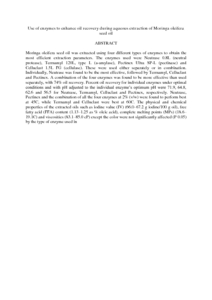Citation
Abdul Karim, Sairah and Lai, Oi Ming and Syed Muhammad, Sharifah Kharidah and Long, Kamariah and Mohd Ghazali, Hasanah
(2006)
Use of enzymes to enhance oil recovery during aqueous extraction of Moringa oleifera seed oil.
Journal of Food Lipids, 13 (2).
pp. 113-130.
ISSN 1745-4522
Abstract
Moringa oleifera seed oil was extracted using four different types of
enzymes to obtain the most efficient extraction parameters. The enzymes used
were Neutrase 0.8L (neutral protease), Termamyl 120L, type L (a-amylase),
Pectinex Ultra SP-L (pectinase) and Celluclast 1.5L FG (cellulase). These
were used either separately or in combination. Individually, Neutrase was
found to be the most effective, followed by Termamyl, Celluclast and Pectinex.
A combination of the four enzymes was found to be more effective than used
separately, with 74% oil recovery. Percent oil recovery for individual enzymes
under optimal conditions and with pH adjusted to the individual enzyme’s
optimum pH were 71.9, 64.8, 62.6 and 56.5 for Neutrase, Termamyl, Celluclast
and Pectinex, respectively. Neutrase, Pectinex and the combination of all
the four enzymes at 2% (v/w) were found to perform best at 45C, while
Termamyl and Celluclast were best at 60C. The physical and chemical properties
of the extracted oils such as iodine value (IV) (66.0–67.2 g iodine/100 g
oil), free fatty acid (FFA) content (1.13–1.25 as % oleic acid), complete
melting points (MPs) (18.6–19.1C) and viscosities (83.1–85.0 cP) except the
color were not significantly affected (P 0.05) by the type of enzyme used in
Download File
![[img]](http://psasir.upm.edu.my/7203/1.hassmallThumbnailVersion/Use%20of%20enzymes%20to%20enhance%20oil%20recovery%20during%20aqueous%20extraction%20of%20Moringa%20oleifera%20seed%20oil.pdf)  Preview |
|
PDF (Abstract)
Use of enzymes to enhance oil recovery during aqueous extraction of Moringa oleifera seed oil.pdf
Download (186kB)
| Preview
|
|
Additional Metadata
Actions (login required)
 |
View Item |

